Pacific Rim, Week 4: Chinese 3
There was a lot of frying this week! Such is the way of a Chinese kitchen. It's a good thing we have stacks and stacks of woks! Clockwise from noon: chicken with snap peas and wild mushrooms, Asian pork ribs, firecracker noodles, chicken chow mein (with its accompanying noodles at center), fried rice with ham and shrimp, and shrimp toasts.
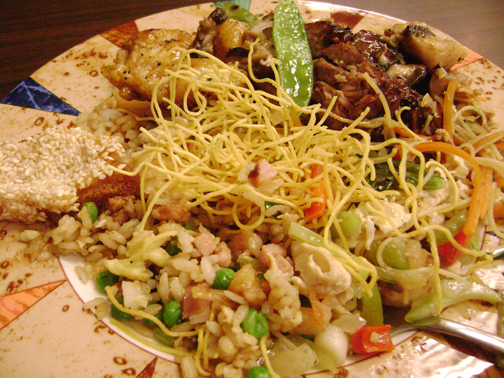
Through the heat lamps--one of my classmates decided to film a little flick with his wee camcorder.
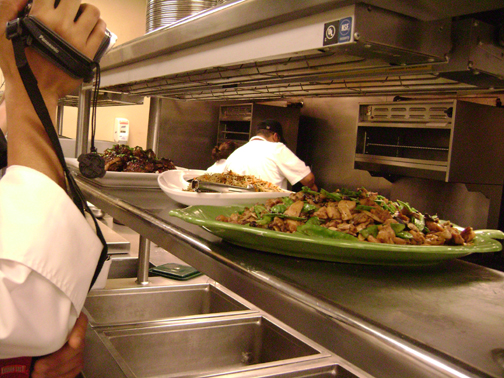
Buddhist Monk's Soup, featuring lentils, coconut milk, squash, and rice noodles. This vegetarian dish was very satiating and tasty.
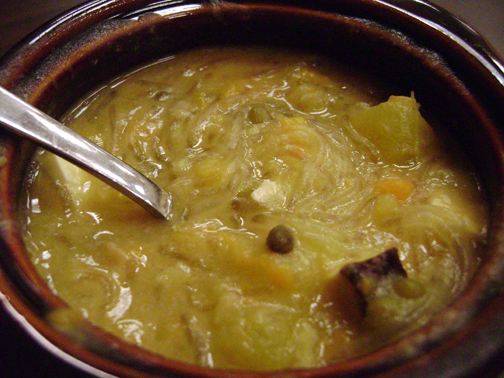
Fried rice with ham and shrimp

Asian pork ribs with a sweet glaze--steamed for quick cooking, then finished on the grill.

Shrimp toasts, coated with a lot of sesame seeds, which didn't taste as strong as it looked. Two of my classmates are cooking up the fried rice in the background.
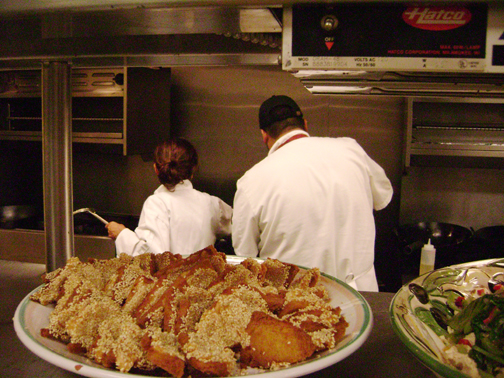
Noodles for chicken chow mein--fried, in the classic Westernized style. The noodles are placed on top of the main components of the dish--in this case, chicken and veggies.

Chicken chow mein without the noodles on top. I would've chopped the choy sum up a bit more. It tastes a lot like bok choy, but is a little more delicate. It looks a lot like bok choy with rapini growing out of the top.
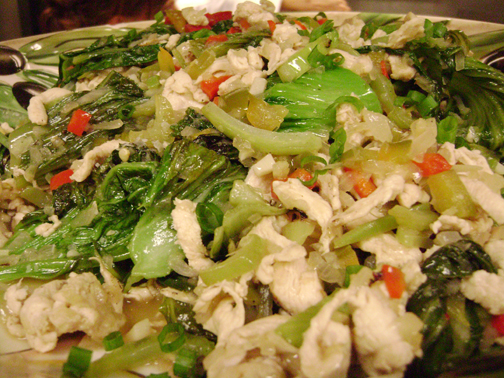
Chinese lemon chicken, made with the somewhat intimidating "double fry" technique. Deep frying in the fry-o-lator is one thing, but deep frying in a large, open, round-bottomed wok and having to move very quickly makes you stop breathing at times.
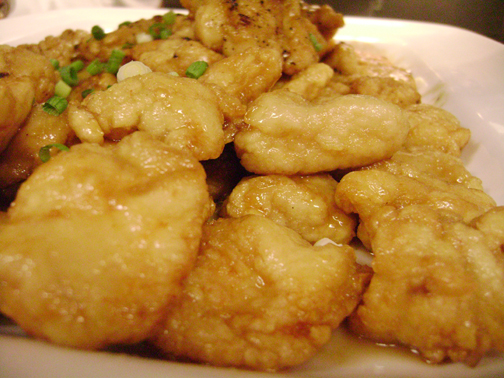
Firecracker noodles, which is very much like the Filipino pancit bihon, and just as sincerely lovable and addictive and reminiscent of home!
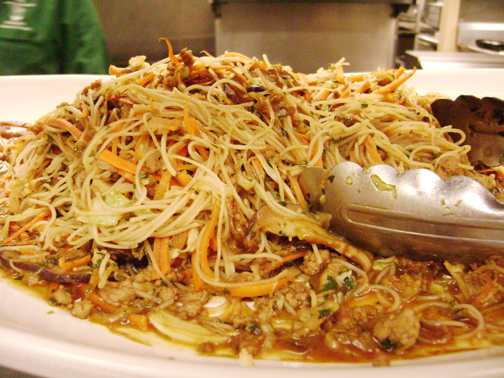
Chicken with snap peas and wild mushrooms. Mmm ... who doesn't love peas?
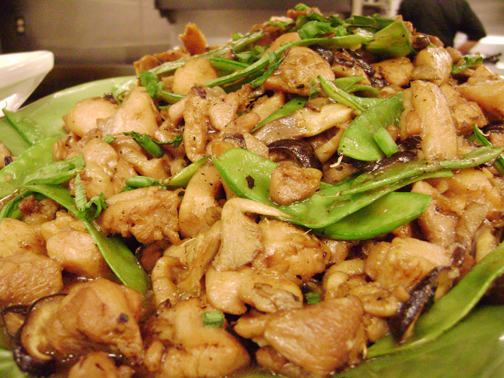
Notes:
Aside from baby backs, good pork ribs can take a long time to cook if you want them to become tender. Unless you steam them. You can simulate steaming them by just baking them in the oven with a tight cover.
Buddhists are vegetarians, but they often add a zing of spice. For our Buddhist monk's soup, we added Buddhist Nuoc Leo, which is chili sauce.
In the U.S., chow mein is often used as a generic term for Chinese noodle dishes. Westernized chow mein is often served with fried, crispy noodles, as shown here, while authentic chow mein is simply stir fried, yielding a soft noodle. Meanwhile, lo mein is originally a soup, or noodles cooked in hot water, similar to Italian pasta. Though all of this noodle info is debatable.
The kind of crispy chicken you find in dishes like lemon chicken is fried twice--first deep fried, then stir fried at a high heat to really crisp it up. While you should batch fry, especially with that second fry, using the same wok for later batches may leave black specks on the food as food burned to the wok flakes off. Don't ask us how we learned this. I'll just say, "The hard way."
To give it a "fried" look, some chefs cook white rice with a brown colorant to make their fried rice a "very brown" color. Others just douse the rice with soy sauce. You don't really need to do either; in fact, a pale rice is closer to the real deal. Fried rice isn't necessarily fried, but its ingredients usually are stir-fried. Finally, to make a good fried rice, use cooled rice instead of hot rice, which will get mushy if you try to continue cooking it in the wok straight out of the steamer. I usually use cold rice the day after I've made it so its had a chance to firm up and dry out.
As chef explains it, shrimp toasts were invented by the Chinese for Americans. He punched the point home as he read the ingredients list, emphasizing the first ingredient: 1 loaf of white bread. The sesame seeds are a UK variant.

Through the heat lamps--one of my classmates decided to film a little flick with his wee camcorder.

Buddhist Monk's Soup, featuring lentils, coconut milk, squash, and rice noodles. This vegetarian dish was very satiating and tasty.

Fried rice with ham and shrimp

Asian pork ribs with a sweet glaze--steamed for quick cooking, then finished on the grill.

Shrimp toasts, coated with a lot of sesame seeds, which didn't taste as strong as it looked. Two of my classmates are cooking up the fried rice in the background.

Noodles for chicken chow mein--fried, in the classic Westernized style. The noodles are placed on top of the main components of the dish--in this case, chicken and veggies.

Chicken chow mein without the noodles on top. I would've chopped the choy sum up a bit more. It tastes a lot like bok choy, but is a little more delicate. It looks a lot like bok choy with rapini growing out of the top.

Chinese lemon chicken, made with the somewhat intimidating "double fry" technique. Deep frying in the fry-o-lator is one thing, but deep frying in a large, open, round-bottomed wok and having to move very quickly makes you stop breathing at times.

Firecracker noodles, which is very much like the Filipino pancit bihon, and just as sincerely lovable and addictive and reminiscent of home!

Chicken with snap peas and wild mushrooms. Mmm ... who doesn't love peas?

Notes:
Aside from baby backs, good pork ribs can take a long time to cook if you want them to become tender. Unless you steam them. You can simulate steaming them by just baking them in the oven with a tight cover.
Buddhists are vegetarians, but they often add a zing of spice. For our Buddhist monk's soup, we added Buddhist Nuoc Leo, which is chili sauce.
In the U.S., chow mein is often used as a generic term for Chinese noodle dishes. Westernized chow mein is often served with fried, crispy noodles, as shown here, while authentic chow mein is simply stir fried, yielding a soft noodle. Meanwhile, lo mein is originally a soup, or noodles cooked in hot water, similar to Italian pasta. Though all of this noodle info is debatable.
The kind of crispy chicken you find in dishes like lemon chicken is fried twice--first deep fried, then stir fried at a high heat to really crisp it up. While you should batch fry, especially with that second fry, using the same wok for later batches may leave black specks on the food as food burned to the wok flakes off. Don't ask us how we learned this. I'll just say, "The hard way."
To give it a "fried" look, some chefs cook white rice with a brown colorant to make their fried rice a "very brown" color. Others just douse the rice with soy sauce. You don't really need to do either; in fact, a pale rice is closer to the real deal. Fried rice isn't necessarily fried, but its ingredients usually are stir-fried. Finally, to make a good fried rice, use cooled rice instead of hot rice, which will get mushy if you try to continue cooking it in the wok straight out of the steamer. I usually use cold rice the day after I've made it so its had a chance to firm up and dry out.
As chef explains it, shrimp toasts were invented by the Chinese for Americans. He punched the point home as he read the ingredients list, emphasizing the first ingredient: 1 loaf of white bread. The sesame seeds are a UK variant.
Comments
I wouldn't mind learning a little more about that double fry technique...I'm going to have to look that up :)
Lewis, the double fry concept is pretty simple: deep fry first to parcook, then stir fry, at high heat as stir fry should always be, to finish cooking and "solidify" the crispy coating. You'd normally do it with meat that's been dipped first in a cornstarch and egg batter, then coated in more cornstarch. If you ever have lemon or orange chicken with a soft, moist crust instead of a crunchy, sauced crust, then it wasn't double-fried correctly or freshly. Hope that makes sense!